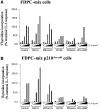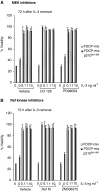Activation of protein kinase A (PKA) by 8-Cl-cAMP as a novel approach for antileukaemic therapy
- PMID: 15188002
- PMCID: PMC2364761
- DOI: 10.1038/sj.bjc.6601909
Activation of protein kinase A (PKA) by 8-Cl-cAMP as a novel approach for antileukaemic therapy
Abstract
Activation of PKA by cAMP agonists, such as 8-Cl-cAMP activation, selectively causes rapid apoptosis in v-abl transformed fibroblasts by inhibiting the Raf-1 kinase. Here we investigated whether 8-Cl-cAMP is useful for the treatment of chronic myelogenous leukaemia (CML), which is hallmarked by the expression of the p210(bcr/abl) oncogene. Autologous bone marrow transplantation is a feasible alternative for patients with no suitable donor, but hampered by the risk of relapse due to the persistence of leukaemia cells in the transplant. To study the effects of 8-Cl-cAMP on primary leukaemic cells, bone marrow cells (BMCs) from eight CML patients (one at diagnosis, three in chronic and four in accelerated phase) were treated. Ex vivo treatment of BMCs obtained in chronic phase of CML with 100 microM 8-Cl-cAMP for 24-48 h led to the selective purging of Philadelphia Chromosome (Ph1 chromosome) without toxic side effects on BMCs from healthy donors as measured by colony-forming unit (CFU) assays. BMCs from patients in accelerated phase showed selective, but incomplete elimination of Ph1 chromosome positive colony forming cells. The mechanism of 8-Cl-cAMP was investigated in FDCP-mix cells transformed by p210(bcr/abl), a cell culture model for CML. The results showed that 8-Cl-cAMP reduced DNA synthesis and viability independent of Raf inhibition as Raf inhibitors had no effect. MEK inhibitors interfered with DNA synthesis, but not with viability. In summary, our results indicate that 8-Cl-cAMP could be useful to purge malignant cells from the bone marrow of patients with CML and certain other forms of leukaemias.
Figures




Similar articles
-
Selection of myeloid progenitors lacking BCR/ABL mRNA in chronic myelogenous leukemia patients after in vitro treatment with the tyrosine kinase inhibitor genistein.Blood. 1996 Oct 15;88(8):3091-100. Blood. 1996. PMID: 8874208
-
Effects of the tyrosine kinase inhibitor AG957 and an Anti-Fas receptor antibody on CD34(+) chronic myelogenous leukemia progenitor cells.Blood. 1999 Jun 1;93(11):3973-82. Blood. 1999. PMID: 10339507
-
8-chloroadenosine 3',5'-monophosphate (8-Cl-cAMP) selectively eliminates protein kinase A type I to induce growth inhibition in c-ras-transformed fibroblasts.Eur J Cancer. 1998 Jul;34(8):1260-7. doi: 10.1016/s0959-8049(98)00051-3. Eur J Cancer. 1998. PMID: 9849489
-
Characterization of cancer stem cells in chronic myeloid leukaemia.Biochem Soc Trans. 2007 Nov;35(Pt 5):1347-51. doi: 10.1042/BST0351347. Biochem Soc Trans. 2007. PMID: 17956348 Review.
-
[Autologous bone marrow transplantation for CML].Nihon Rinsho. 2001 Dec;59(12):2369-74. Nihon Rinsho. 2001. PMID: 11766341 Review. Japanese.
Cited by
-
Loss of Prkar1a leads to Bcl-2 family protein induction and cachexia in mice.Cell Death Differ. 2014 Nov;21(11):1815-24. doi: 10.1038/cdd.2014.98. Epub 2014 Jul 11. Cell Death Differ. 2014. PMID: 25012505 Free PMC article.
-
Multiple G-protein-coupling specificity of beta-adrenoceptor in macrophages.Immunology. 2007 Dec;122(4):503-13. doi: 10.1111/j.1365-2567.2007.02658.x. Epub 2007 Oct 19. Immunology. 2007. PMID: 17949419 Free PMC article.
-
Quantitative proteomics analysis of the cAMP/protein kinase A signaling pathway.Biochemistry. 2012 Nov 20;51(46):9323-32. doi: 10.1021/bi301282k. Epub 2012 Nov 12. Biochemistry. 2012. PMID: 23110364 Free PMC article.
-
8-Cl-cAMP and PKA I-selective cAMP analogs effectively inhibit undifferentiated thyroid cancer cell growth.Endocrine. 2017 May;56(2):388-398. doi: 10.1007/s12020-016-1057-8. Epub 2016 Jul 27. Endocrine. 2017. PMID: 27460006
-
Gene expression patterns define key transcriptional events in cell-cycle regulation by cAMP and protein kinase A.Proc Natl Acad Sci U S A. 2005 Jun 14;102(24):8561-6. doi: 10.1073/pnas.0503363102. Epub 2005 Jun 6. Proc Natl Acad Sci U S A. 2005. PMID: 15939874 Free PMC article.
References
-
- Beran M, Cao X, Estrov Z, Jeha S, Jin G, O'Brian S, Talpaz M, Arlinghausen RB, Lydon NB, Kantarjian H (1998) Selective inhibition of cell proliferation and BCR-ABL phosphorylation in acute lymphoblastic leukemia cells expressing Mr 190 000 BCR-ABL protein by a tyrosine kinase inhibitor (CGP-57148). Clin Cancer Res 4: 1661. - PubMed
-
- Brentnall HJ, Hutchinson DW (1972) Preparation of 8-chloroadenosine and its phosphate esters. Tetrahedron Lett 25: 2595
-
- Butturini A, Arlinghausen RB, Gale RP (1996) BCR/ABL and leukemia. Leuk Res 20: 523. - PubMed
Publication types
MeSH terms
Substances
LinkOut - more resources
Full Text Sources
Medical
Research Materials
Miscellaneous

